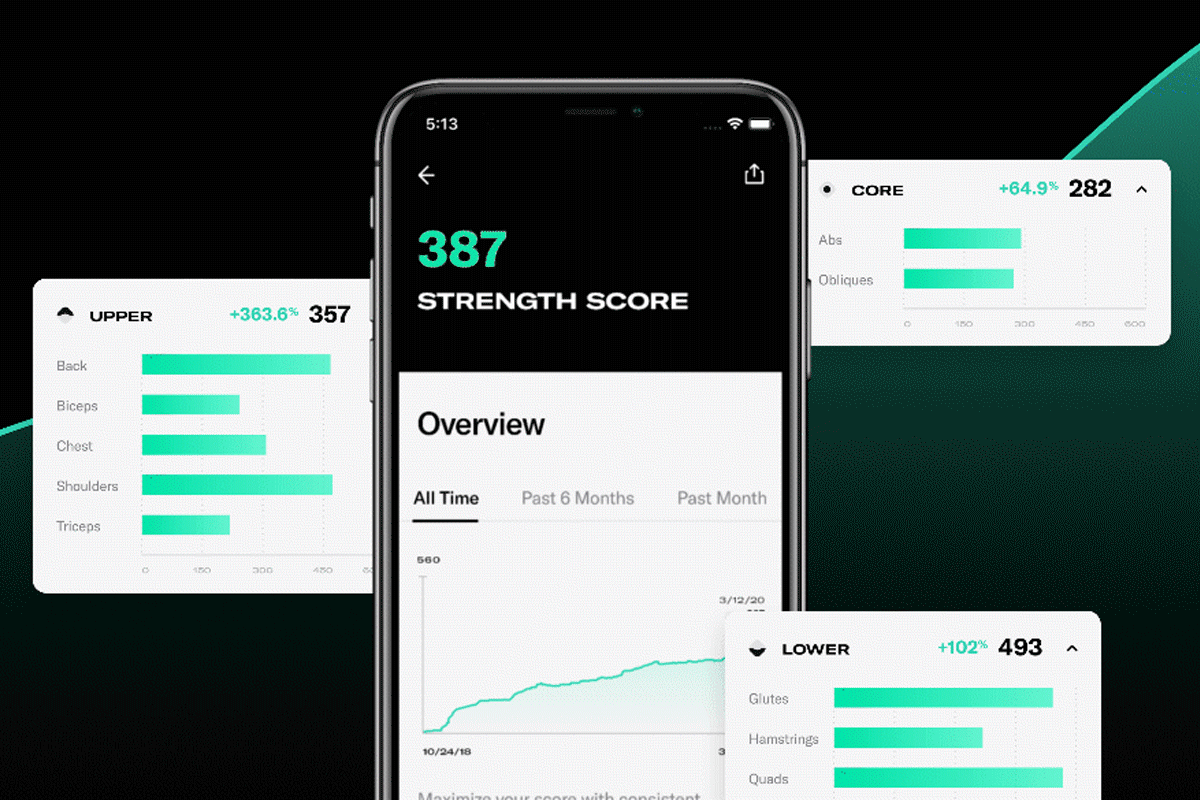How to interpret this metric depending on your goals.

One of the most fulfilling parts of gaining strength is tracking your progress. Whether it’s your squat PR or body composition measurements seeing those data points improve is proof that your hard work is paying off. It’s not surprising then, that some athletes love tracking as many metrics as possible.
When you lift on Tonal, one metric you’ll see after every workout is your time under tension. It’s likely not something you’re used to measuring on your own, but this number can actually tell you a lot about your workout. Here’s how you can interpret your time under tension and use it to evaluate your progress and reach your goals.
What Does Time Under Tension Mean?
Time under tension is the portion of your workout during which your muscles are under load (or resistance). If you’re doing a bench press set with a barbell, it would be measured from when you start your first rep to when you finish your last rep. On Tonal, time under tension (for each set) is measured from the time you turn the weight on to the second you turn it off. Add up the cumulative time for all the sets in your workout, and you’ve got your total time under tension.
It doesn’t include rest periods between sets or the time you spend off-Tonal warming up and cooling down. Warm-up sets at a reduced weight on Tonal do count toward your total. That’s why you might finish a 45-minute workout and see you’ve only spent 12 minutes under tension.
That doesn’t mean the rest of your workout time isn’t productive. Jenna Moore, a certified strength and conditioning coach and Programming Specialist at Tonal, explains that, especially during workouts focused on building strength, long rest periods are necessary to ensure you’ll be able to lift as heavy as possible during your sets.
“Whenever we have a workout where we have longer rest periods, you’re going to have less time under tension relative to the total workout time,” she says. “It’s okay to only have eight minutes of time under tension in a 60-minute workout when you’re doing something that’s strength-based.”
You can expect your time under tension to vary based on the type of workout you’re doing and your goals. Moore explains that in hypertrophy workouts (where the emphasis is on increasing muscle mass), it’s typically closer to 25 to 30 percent of total workout time. In a high-intensity session that’s all about endurance-based work capacity, she says it’s not uncommon to see time under tension be 50 percent or more of total workout time.
Does Time Under Tension Build Muscle?
Just as your weight on the scale or Strength Score is only one data point in evaluating your overall health and fitness, time under tension is most useful when considered in the context of the rest of your workout.
Instead of focusing on increasing this number on its own (in a 2022 study, varying time under tension had no effect on muscle size), concentrate on other variables in your workout, including volume, form, and work capacity, that will lead to a higher time under tension.
Time Under Tension and Volume
When it comes to hypertrophy, volume increases have consistently been shown to improve muscle size and mass—and if you’re gradually raising your workout volume, your time under tension will reflect that.
“If you lift with the same speed but increase the amount of volume that you do—the number of sets or the number of reps—you will increase your time under tension,” says Troy Taylor, Senior Director of Performance at Tonal.
As this review of studies has shown, performing 10 sets or more for a muscle group each week is optimal for hypertrophy. If you’re currently doing fewer sets per muscle group and have a goal to work up to that higher range, you’ll naturally see an increase in your weekly time under tension as you build volume. While this number is increasing, it’s really the higher volume that’s going to affect your gains.
“If you lift with the same speed but increase the amount of volume that you do—the number of sets or the number of reps—you will increase your time under tension.”
– Troy Taylor, Senior Director of Performance at Tonal
If you tried lifting slower to increase your time under tension, Taylor explains you’d fatigue faster and therefore end up lifting less volume even if your time under tension increased. As long as you’re lifting at a controlled tempo and not so fast that you’re using momentum or jerking the weight around, Taylor says you’re still creating mechanical tension within the muscle.
Time under tension can also be a measure of progressive overload (the gradual increase in stress on the body in the form of resistance, volume, intensity, or frequency) and will rise as your overall volume builds. “You want to watch that number slowly increase as you are progressing [and] overloading the muscles systematically from workout to workout and week to week,” says Moore.
Time Under Tension and Form
Lifting with proper form in your full range of motion will also naturally increase time under tension. “You’re getting more time under tension through the fullest range of motion, which is exposing those muscles to the most stress possible,” says Christian Hartford, Senior Performance Manager of Applied Sports Science at Tonal. “It’s less about the time and more about the mechanical stress and the actual load that you’re putting onto the body.”
“It’s not the slower, the better. It’s the more controlled, the better.”
– Christian Hartford, Senior Performance Manager of Applied Sports Science at Tonal
On Tonal, features such as Form Feedback and Smart View evaluate your form in real-time during your workouts and give you tips on how to improve. Additionally, if you want to increase your range of motion, try mobility sessions that are geared toward helping you move better in all your lifts.
“It’s not the slower, the better,” says Hartford. “It’s the more controlled, the better. More controlled, full range of motion reps, with better muscular contraction, will enhance time under tension, therefore enhancing mechanical stress and muscular strength development.”
Zeroing in on form ensures you won’t be repping it out too fast or too slow, but rather at just the right tempo to challenge your muscles appropriately.
Time Under Tension and Work Capacity
Since time under tension measures the density of your workout (how much work you do in a set period of time), it may be a more useful metric if your goal is to improve fitness or lose fat. “If you’re not decreasing volume, but you’re increasing time under tension, then you’ll get more work in a lesser period of time so you can increase efficiency,” says Taylor. On Tonal, you’re more likely to see higher time under tension readings with Get Lean programs and workouts, according to Wilking
This efficiency, or increased work capacity, may also help your strength gains. As data on Tonal members has shown, spending more time lifting within a workout is linked to greater strength improvements. Improving your work capacity is a sure sign you’re getting fitter and gaining muscular endurance. “People who generally pack in a lot of work, with appropriate but not excessive recovery, get stronger than people who don’t pack in a lot of work,” says Taylor.


